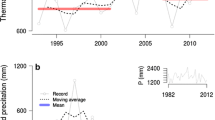ABSTRACT
Herbivore grazing is increasingly used as a management tool to prevent the dominance of vegetation by tall grasses or trees. In this report, a model is described that is used to analyze plant-herbivore interactions and their scaling up to landscape scale. The model can be used to predict effects of herbivory on vegetation development. The model is an ecosystem model including modules for carbon and nitrogen cycling through plants, soil organic matter, and atmosphere. Plants compete for light and nitrogen. An herbivory module is included that implements selective foraging by a herbivore in a spatially heterogeneous area. Simulations were done to analyze the effects of herbivore density on vegetation dynamics, to analyze the impact of soil fertility on maximum herbivore density, and to analyze effects of herbivore density on landscapes. Two important points come forward from the model. Maximum herbivore abundance shows a hump-shaped curve along a soil fertility gradient. At higher soil fertility, light competition becomes more important. Herbivory interferes with plant competition, giving the tall, less palatable species a competitive advantage and thereby reducing the food quality and availability and hence the carrying capacity of the area. At a landscape scale, herbivory leads to increased heterogeneity. This increased heterogeneity may increase carrying capacity. The implications of these points for nature management are discussed.
Similar content being viewed by others
Author information
Authors and Affiliations
Additional information
Received 13 May 1998; accepted 23 November 1998.
Rights and permissions
About this article
Cite this article
van Oene, H., Mieleke van Deursen, E. & Berendse, F. Plant-Herbivore Interaction and Its Consequences for Succession in Wetland Ecosystems: A Modeling Approach. Ecosystems 2, 122–138 (1999). https://doi.org/10.1007/s100219900064
Issue Date:
DOI: https://doi.org/10.1007/s100219900064




